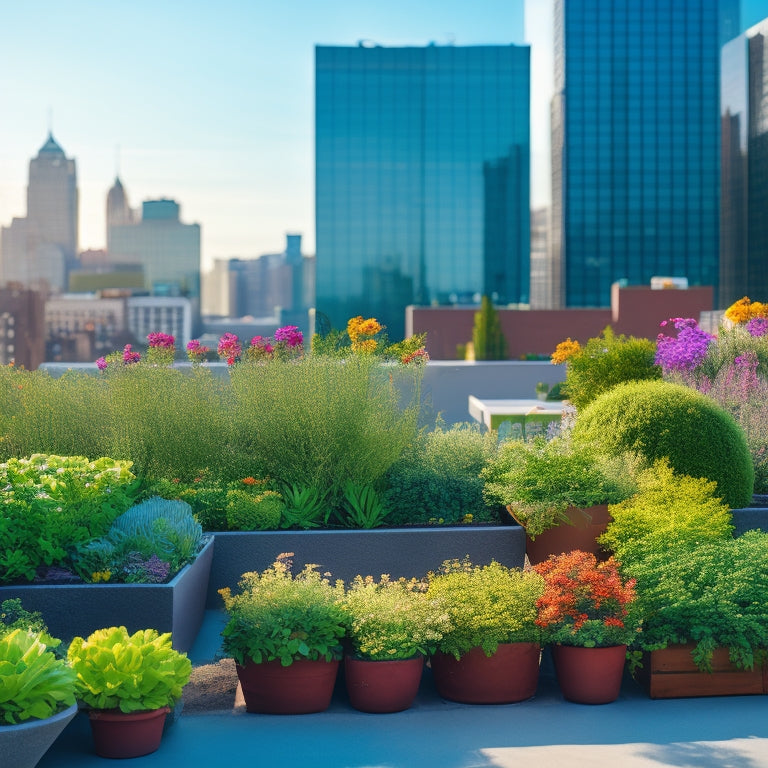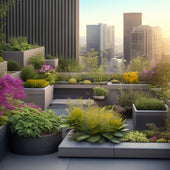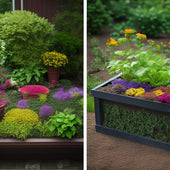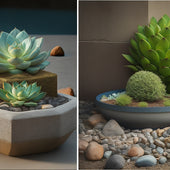
Choosing the Right Plants for Your Green Roof
Share
When selecting plants for your green roof, you need to take into account the unique conditions they'll encounter, including temperature fluctuations, high UV exposure, and limited soil depth. Evaluate your roof's climate, soil composition, and sunlight patterns to choose plants that will thrive. Consider plant size, growth rate, and maintenance needs, as well as drought tolerance and water requirements. Harmonize aesthetics with functionality by choosing plants that align with your design goals and deliver the desired visual impact. By balancing these factors, you'll create a stunning, low-maintenance green roof that will flourish – and there's more to explore to maximize your space's potential.
Assessing Climate and Soil Conditions
As you prepare to design your green roof, assess the local climate and soil conditions to determine which plants will thrive in the unique environment you're creating. Climate considerations include temperature fluctuations, sunlight exposure, and precipitation patterns, which will influence plant adaptation and biodiversity.
For instance, if you live in a region with intense sunlight, choose plants with built-in UV protection or those that can tolerate high temperatures.
Soil composition is also pivotal, as it affects drainage, aeration, and nutrient availability. A well-draining mix is essential to prevent waterlogged soil, which can lead to root rot and other issues.
Consider the soil's pH level, nutrient content, and organic matter percentage when selecting plants. For example, if your soil is highly alkaline, choose plants that can tolerate or even prefer these conditions.
Plant Size and Growth Rate
When selecting plants for your green roof, consider the mature size of each species and its growth rate to guarantee a visually appealing, well-proportioned landscape that doesn't overcrowd or underutilize space. This is pivotal for plant selection, as it directly impacts the overall aesthetic and functionality of your green roof.
Some key growth considerations to keep in mind include:
-
Vertical growth: Will the plants grow tall and slender, or spread horizontally, affecting the overall layout?
-
Spreading habits: Will the plants spread quickly, potentially outcompeting other species, or remain compact and contained?
-
Maturation time: How long will it take for the plants to reach their mature size, and how will this impact your maintenance schedule?
-
Pruning requirements: Will the plants require regular pruning to maintain their shape and size, or can they be left to grow freely?
-
Seasonal changes: How will the plants respond to changing seasons, and will they provide year-round interest?
Maintenance and Care Requirements
When selecting plants for your green roof, you'll want to think about the maintenance and care requirements to guarantee the health and longevity of your rooftop garden.
You'll need to contemplate how you'll meet the watering and irrigation needs of your plants, as well as how you'll control pests and diseases.
Additionally, you'll need to plan for seasonal pruning requirements to uphold a visually appealing and well-maintained space.
Watering and Irrigation Needs
By carefully selecting plants with similar watering requirements, you can simplify irrigation needs and reduce maintenance tasks for your green roof. This approach guarantees that your plants receive the right amount of water, minimizing waste and preventing waterlogged soil.
When it comes to watering and irrigation, consider the following key factors:
-
Smart irrigation systems: Install a smart irrigation system that can detect soil moisture levels and adjust watering schedules accordingly.
-
Water retention: Choose plants with high water retention properties to reduce the frequency of watering.
-
Drainage: Guarantee proper drainage to prevent water accumulation and root rot.
-
Soil type: Select soil that drains well and retains moisture, but not too much.
-
Weather monitoring: Monitor weather forecasts to adjust irrigation schedules and avoid overwatering during rainy periods.
Pest and Disease Control
As you optimize your green roof's irrigation system, don't overlook the potential threats lurking beneath the surface - pests and diseases that can quickly destroy your carefully selected plantings.
To mitigate these risks, adopt an integrated pest management (IPM) approach that combines physical, cultural, biological, and chemical controls. Encourage natural enemies, such as ladybugs and lacewings, by incorporating insect-friendly plants into your design.
When selecting plants, opt for disease-resistant varieties that are less susceptible to common green roof pathogens. Implement preventive measures like crop rotation, sanitation, and pruning to prevent disease spread.
Regularly inspect your roof for signs of pests or diseases, and respond promptly to prevent infestations from escalating. Consider using physical barriers, like fine-mesh screens, to exclude pests from your plants.
By taking a proactive, multi-faceted approach to pest and disease control, you'll be better equipped to protect your green roof investment and secure a thriving, resilient ecosystem.
Seasonal Pruning Requirements
You'll need to prune your green roof plants regularly to maintain their health, promote dense growth, and prevent erosion, with seasonal pruning schedules varying depending on the specific plant species and climate.
As you plan your seasonal pruning schedule, consider the unique needs of each plant species and how they respond to different pruning techniques.
Here are some key factors to keep in mind:
-
Dormant season pruning: Prune deciduous plants during their dormant season to minimize stress and prevent disease.
-
Flowering plants: Prune plants that produce flowers in the spring or summer immediately after blooming to encourage new growth.
-
Succulents and sedums: Prune these plants lightly to maintain shape and promote healthy growth patterns.
-
Grasses and groundcovers: Prune these plants regularly to maintain a uniform height and prevent overgrowth.
-
Climate-specific pruning: Adjust your pruning schedule based on your local climate, taking into account factors like frost, heat, and drought.
Drought Tolerance and Water Needs
How will your green roof plants fare during dry spells, and what're their water requirements?
When selecting plants, it's essential to ponder their drought tolerance to minimize water consumption and environmental impact. Plants with low water needs will thrive in green roofs with limited irrigation systems. Look for species with adaptations such as deep roots, succulent leaves, or waxy coatings that prevent water loss.
Water conservation is key in green roof design. By choosing plants with varying water requirements, you'll create a diverse and resilient ecosystem. For instance, combining drought-tolerant sedums with moisture-loving grasses will guarantee your roof remains vibrant throughout the year.
Aim for a mix of plants that require minimal irrigation, such as 1-2 inches of water per week, to reduce your roof's water footprint. By doing so, you'll not only conserve water but also support local biodiversity. Remember, plant selection is pivotal in achieving a sustainable and visually appealing green roof that benefits both you and the environment.
Sunlight and Shade Tolerance
Assessing your green roof's exposure to sunlight and shade is critical, given that plants have varying levels of tolerance to these conditions. When selecting plants, it's crucial to take into account the amount of direct sunlight and shade your roof receives, as this will impact plant growth and survival.
To ensure ideal plant placement, take into account the microclimates on your roof. Some areas may receive full sun, while others may be shaded by surrounding buildings or structures. By understanding these variations, you can choose plants that thrive in specific conditions.
Here are some key factors to keep in mind:
-
Full sun: plants that need at least 6 hours of direct sunlight
-
Partial shade: plants that can handle 4-6 hours of direct sunlight
-
Full shade: plants that flourish in low-light conditions
-
Dappled shade: plants that benefit from filtered sunlight
-
East- or west-facing slopes: plants that prefer gentle, indirect sunlight
Selecting Plants for Aesthetics
As you consider the specific growing conditions on your green roof, you're likely thinking about the visual impact you want to achieve, and that's where selecting plants for aesthetics comes in. This is your chance to create a visually stunning space that complements your building's architecture and surroundings.
Start by selecting a color palette that resonates with your design goals. Do you prefer bold and vibrant, or soft and muted? Choose plants with foliage and flowers that fit within your desired color scheme.
Next, consider plant placement to create design cohesion. Group plants with similar textures, forms, and growth habits together to create visually appealing combinations. Don't forget to balance massing and spacing to achieve a sense of harmony.
Frequently Asked Questions
Can I Use Plants From My Garden on My Green Roof?
You're tempted to reuse plants from your garden on your green roof, but consider compatibility issues - garden plants may not thrive in roof conditions. Make sure selected plants integrate with your roof's specific maintenance needs.
Will Plants Attract Pests or Rodents to My Building?
As you consider the impact of plants on your building, you'll find that some species do attract pests or rodents, but strategic pest prevention through plant selection and incorporating rodent deterrents like lavender and mint into your variety can mitigate these risks.
Do Green Roofs Require a Special Irrigation System?
You'll need a reliable irrigation system for your green roof, as it requires consistent moisture levels. Opt for efficient irrigation methods, like drip irrigation or rainwater harvesting, to maximize green roof benefits while minimizing water waste.
Can I Walk or Stand on My Green Roof?
'When you step onto your green roof, make sure you're wearing soft-soled shoes to prevent damage. Prioritize green roof safety by limiting access and avoiding heavy foot traffic, allowing for efficient plant maintenance and minimizing erosion risk.'
Are There Any Weight Restrictions for Green Roof Plants?
'A million pounds of plants won't magically defy gravity! You'll need to take into account weight limits to guarantee your roof's structural integrity. Select plants with low maintenance requirements and consult with a structural engineer to determine the perfect balance.'
Related Posts
-

Irrigation System Design Ideas for Concrete Planters
As you design an irrigation system for your concrete planters, you'll need to balance drainage, moisture retention, a...
-

Irrigation System Design Ideas for Concrete Planters
As you design an irrigation system for your concrete planters, you'll need to balance drainage, moisture retention, a...
-

Irrigation System Design Ideas for Concrete Planters
As you design an irrigation system for your concrete planters, you'll need to balance drainage, moisture retention, a...
-

Irrigation System Design Ideas for Concrete Planters
As you design an irrigation system for your concrete planters, you'll need to balance drainage, moisture retention, a...
-

Irrigation System Design Ideas for Concrete Planters
As you design an irrigation system for your concrete planters, you'll need to balance drainage, moisture retention, a...
-

Irrigation System Design Ideas for Concrete Planters
As you design an irrigation system for your concrete planters, you'll need to balance drainage, moisture retention, a...
-

Irrigation System Design Ideas for Concrete Planters
As you design an irrigation system for your concrete planters, you'll need to balance drainage, moisture retention, a...
-

Irrigation System Design Ideas for Concrete Planters
As you design an irrigation system for your concrete planters, you'll need to balance drainage, moisture retention, a...
-

Irrigation System Design Ideas for Concrete Planters
As you design an irrigation system for your concrete planters, you'll need to balance drainage, moisture retention, a...
-

Irrigation System Design Ideas for Concrete Planters
As you design an irrigation system for your concrete planters, you'll need to balance drainage, moisture retention, a...
-

Irrigation System Design Ideas for Concrete Planters
As you design an irrigation system for your concrete planters, you'll need to balance drainage, moisture retention, a...
-

Irrigation System Design Ideas for Concrete Planters
As you design an irrigation system for your concrete planters, you'll need to balance drainage, moisture retention, a...
-

Irrigation System Design Ideas for Concrete Planters
As you design an irrigation system for your concrete planters, you'll need to balance drainage, moisture retention, a...
-

Irrigation System Design Ideas for Concrete Planters
As you design an irrigation system for your concrete planters, you'll need to balance drainage, moisture retention, a...
-

Irrigation System Design Ideas for Concrete Planters
As you design an irrigation system for your concrete planters, you'll need to balance drainage, moisture retention, a...
-

Irrigation System Design Ideas for Concrete Planters
As you design an irrigation system for your concrete planters, you'll need to balance drainage, moisture retention, a...
-

Irrigation System Design Ideas for Concrete Planters
As you design an irrigation system for your concrete planters, you'll need to balance drainage, moisture retention, a...
-

Irrigation System Design Ideas for Concrete Planters
As you design an irrigation system for your concrete planters, you'll need to balance drainage, moisture retention, a...
-

Irrigation System Design Ideas for Concrete Planters
As you design an irrigation system for your concrete planters, you'll need to balance drainage, moisture retention, a...
-

Irrigation System Design Ideas for Concrete Planters
As you design an irrigation system for your concrete planters, you'll need to balance drainage, moisture retention, a...
-

Irrigation System Design Ideas for Concrete Planters
As you design an irrigation system for your concrete planters, you'll need to balance drainage, moisture retention, a...
-

Irrigation System Design Ideas for Concrete Planters
As you design an irrigation system for your concrete planters, you'll need to balance drainage, moisture retention, a...
-

Irrigation System Design Ideas for Concrete Planters
As you design an irrigation system for your concrete planters, you'll need to balance drainage, moisture retention, a...
-

Irrigation System Design Ideas for Concrete Planters
As you design an irrigation system for your concrete planters, you'll need to balance drainage, moisture retention, a...
-

Irrigation System Design Ideas for Concrete Planters
As you design an irrigation system for your concrete planters, you'll need to balance drainage, moisture retention, a...
-

Irrigation System Design Ideas for Concrete Planters
As you design an irrigation system for your concrete planters, you'll need to balance drainage, moisture retention, a...
-

Irrigation System Design Ideas for Concrete Planters
As you design an irrigation system for your concrete planters, you'll need to balance drainage, moisture retention, a...
-

Irrigation System Design Ideas for Concrete Planters
As you design an irrigation system for your concrete planters, you'll need to balance drainage, moisture retention, a...
-

Irrigation System Design Ideas for Concrete Planters
As you design an irrigation system for your concrete planters, you'll need to balance drainage, moisture retention, a...
-

Irrigation System Design Ideas for Concrete Planters
As you design an irrigation system for your concrete planters, you'll need to balance drainage, moisture retention, a...
-

Irrigation System Design Ideas for Concrete Planters
As you design an irrigation system for your concrete planters, you'll need to balance drainage, moisture retention, a...
-

Soil Selection for Successful Planter Garden Boxes
When selecting soil for your planter garden box, it's important to balance drainage, moisture retention, and nutrient...
-

Soil Selection for Successful Planter Garden Boxes
When selecting soil for your planter garden box, it's important to balance drainage, moisture retention, and nutrient...
-

Soil Selection for Successful Planter Garden Boxes
When selecting soil for your planter garden box, it's important to balance drainage, moisture retention, and nutrient...
-

Soil Selection for Successful Planter Garden Boxes
When selecting soil for your planter garden box, it's important to balance drainage, moisture retention, and nutrient...
-

Soil Selection for Successful Planter Garden Boxes
When selecting soil for your planter garden box, it's important to balance drainage, moisture retention, and nutrient...
-

Soil Selection for Successful Planter Garden Boxes
When selecting soil for your planter garden box, it's important to balance drainage, moisture retention, and nutrient...
-

Soil Selection for Successful Planter Garden Boxes
When selecting soil for your planter garden box, it's important to balance drainage, moisture retention, and nutrient...
-

Soil Selection for Successful Planter Garden Boxes
When selecting soil for your planter garden box, it's important to balance drainage, moisture retention, and nutrient...
-

Soil Selection for Successful Planter Garden Boxes
When selecting soil for your planter garden box, it's important to balance drainage, moisture retention, and nutrient...
-

Soil Selection for Successful Planter Garden Boxes
When selecting soil for your planter garden box, it's important to balance drainage, moisture retention, and nutrient...
-

Soil Selection for Successful Planter Garden Boxes
When selecting soil for your planter garden box, it's important to balance drainage, moisture retention, and nutrient...
-

Soil Selection for Successful Planter Garden Boxes
When selecting soil for your planter garden box, it's important to balance drainage, moisture retention, and nutrient...
-

Soil Selection for Successful Planter Garden Boxes
When selecting soil for your planter garden box, it's important to balance drainage, moisture retention, and nutrient...
-

Soil Selection for Successful Planter Garden Boxes
When selecting soil for your planter garden box, it's important to balance drainage, moisture retention, and nutrient...
-

Soil Selection for Successful Planter Garden Boxes
When selecting soil for your planter garden box, it's important to balance drainage, moisture retention, and nutrient...
-

Soil Selection for Successful Planter Garden Boxes
When selecting soil for your planter garden box, it's important to balance drainage, moisture retention, and nutrient...
-

Soil Selection for Successful Planter Garden Boxes
When selecting soil for your planter garden box, it's important to balance drainage, moisture retention, and nutrient...
-

Soil Selection for Successful Planter Garden Boxes
When selecting soil for your planter garden box, it's important to balance drainage, moisture retention, and nutrient...
-

Soil Selection for Successful Planter Garden Boxes
When selecting soil for your planter garden box, it's important to balance drainage, moisture retention, and nutrient...
-

Soil Selection for Successful Planter Garden Boxes
When selecting soil for your planter garden box, it's important to balance drainage, moisture retention, and nutrient...
-

Soil Selection for Successful Planter Garden Boxes
When selecting soil for your planter garden box, it's important to balance drainage, moisture retention, and nutrient...
-

Soil Selection for Successful Planter Garden Boxes
When selecting soil for your planter garden box, it's important to balance drainage, moisture retention, and nutrient...
-

Soil Selection for Successful Planter Garden Boxes
When selecting soil for your planter garden box, it's important to balance drainage, moisture retention, and nutrient...
-

Soil Selection for Successful Planter Garden Boxes
When selecting soil for your planter garden box, it's important to balance drainage, moisture retention, and nutrient...
-

Soil Selection for Successful Planter Garden Boxes
When selecting soil for your planter garden box, it's important to balance drainage, moisture retention, and nutrient...
-

Soil Selection for Successful Planter Garden Boxes
When selecting soil for your planter garden box, it's important to balance drainage, moisture retention, and nutrient...
-

Soil Selection for Successful Planter Garden Boxes
When selecting soil for your planter garden box, it's important to balance drainage, moisture retention, and nutrient...
-

Soil Selection for Successful Planter Garden Boxes
When selecting soil for your planter garden box, it's important to balance drainage, moisture retention, and nutrient...
-

Soil Selection for Successful Planter Garden Boxes
When selecting soil for your planter garden box, it's important to balance drainage, moisture retention, and nutrient...
-

Soil Selection for Successful Planter Garden Boxes
When selecting soil for your planter garden box, it's important to balance drainage, moisture retention, and nutrient...
-

Soil Selection for Successful Planter Garden Boxes
When selecting soil for your planter garden box, it's important to balance drainage, moisture retention, and nutrient...
-

Soil Selection for Successful Planter Garden Boxes
When selecting soil for your planter garden box, it's important to balance drainage, moisture retention, and nutrient...
-

Succulent-Friendly Drainage Solutions for Block Planters
You can create a succulent-friendly drainage system in your cinder block planters by drilling holes in the bottom of ...
-

Succulent-Friendly Drainage Solutions for Block Planters
You can create a succulent-friendly drainage system in your cinder block planters by drilling holes in the bottom of ...
-

Succulent-Friendly Drainage Solutions for Block Planters
You can create a succulent-friendly drainage system in your cinder block planters by drilling holes in the bottom of ...
-

Succulent-Friendly Drainage Solutions for Block Planters
You can create a succulent-friendly drainage system in your cinder block planters by drilling holes in the bottom of ...
-

Succulent-Friendly Drainage Solutions for Block Planters
You can create a succulent-friendly drainage system in your cinder block planters by drilling holes in the bottom of ...
-

Succulent-Friendly Drainage Solutions for Block Planters
You can create a succulent-friendly drainage system in your cinder block planters by drilling holes in the bottom of ...
-

Succulent-Friendly Drainage Solutions for Block Planters
You can create a succulent-friendly drainage system in your cinder block planters by drilling holes in the bottom of ...
-

Succulent-Friendly Drainage Solutions for Block Planters
You can create a succulent-friendly drainage system in your cinder block planters by drilling holes in the bottom of ...
-

Succulent-Friendly Drainage Solutions for Block Planters
You can create a succulent-friendly drainage system in your cinder block planters by drilling holes in the bottom of ...
-

Succulent-Friendly Drainage Solutions for Block Planters
You can create a succulent-friendly drainage system in your cinder block planters by drilling holes in the bottom of ...
-

Succulent-Friendly Drainage Solutions for Block Planters
You can create a succulent-friendly drainage system in your cinder block planters by drilling holes in the bottom of ...
-

Succulent-Friendly Drainage Solutions for Block Planters
You can create a succulent-friendly drainage system in your cinder block planters by drilling holes in the bottom of ...
-

Succulent-Friendly Drainage Solutions for Block Planters
You can create a succulent-friendly drainage system in your cinder block planters by drilling holes in the bottom of ...
-

Succulent-Friendly Drainage Solutions for Block Planters
You can create a succulent-friendly drainage system in your cinder block planters by drilling holes in the bottom of ...
-

Succulent-Friendly Drainage Solutions for Block Planters
You can create a succulent-friendly drainage system in your cinder block planters by drilling holes in the bottom of ...


